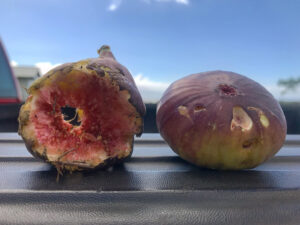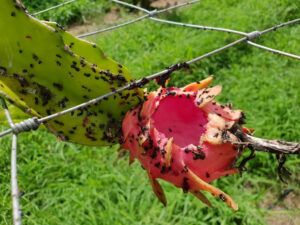Project Overview
Information Products
Commodities
- Fruits: figs
Practices
- Education and Training: demonstration, display, farmer to farmer, on-farm/ranch research, technical assistance
- Pest Management: integrated pest management, prevention
Summary:
 Comparing Bird Deterrent Strategies to Increase
Comparing Bird Deterrent Strategies to Increase  Sustainability and Production of Fruit Crops in Hawaii.
Sustainability and Production of Fruit Crops in Hawaii.
Birds are responsible for damaging many high value fruit crops in Hawaii, making a significant detrimental economic impact for local farmers and creates barriers to entry for new farmers. They spread disease and ruin crops. These affected crops include dragonfruit, figs, mangos, lychee and longan. Farmers are presented with various methods of protection and deterrence. Many of these methods are expensive, labor intensive, impractical and often ineffective. The subject research looks to examine the cost/effectiveness of two conventional methods of bird pest deterrence, and compare it to one novel method. The methods are conventional netting (exclusion), conventional reflectors (visual stimuli), and an innovative method of utilizing an automated visible Agrilaser.
Current practices include sound machines, hunting, bitterants, reflectors, bird netting, and bagging fruit before harvest. These methods are problematic as the birds quickly adapt to these deterrents. Netting and bagging are labor intensive, additionally the materials used are expensive and often do not survive an entire season. Many fruit crops do not lend themselves to these practices due to the size of the tree or the fruit.
The project will test this innovative and humane form of pest deterrent in Hawaii and compare it against conventional methods for use on dragonfruit and fig crops. The project will use a visible laser system to keep birds out of a specified area of crops. This method differs from others in that the birds view the laser beam as a physical object, and they avoid it without adapting. This system is mounted on a programmable base, so that the deterrent can be applied to any crop-producing field within a 6,500-foot radius. The system is programmed once with the specific parameters of the area to be treated. It can operate 24 hours a day, 7 days a week, within these parameters.
Project objectives:
- Design an executable set of trials.
- Install Agrilaser equipment, conventional netting, and conventional deterrents.
- Gather yield data for treated vs non-treated areas
- Gather yield data for netted vs non-netted areas
- Qualify cost/effectiveness.
- Conclude which method is the most cost effective.
- Present results through presentation, field-days, and on-line video to wide Hawaiian based audience on multiple islands.
- Assist interested farmers in coordinating, attaining, and setting up the most cost effective methods for their operations.